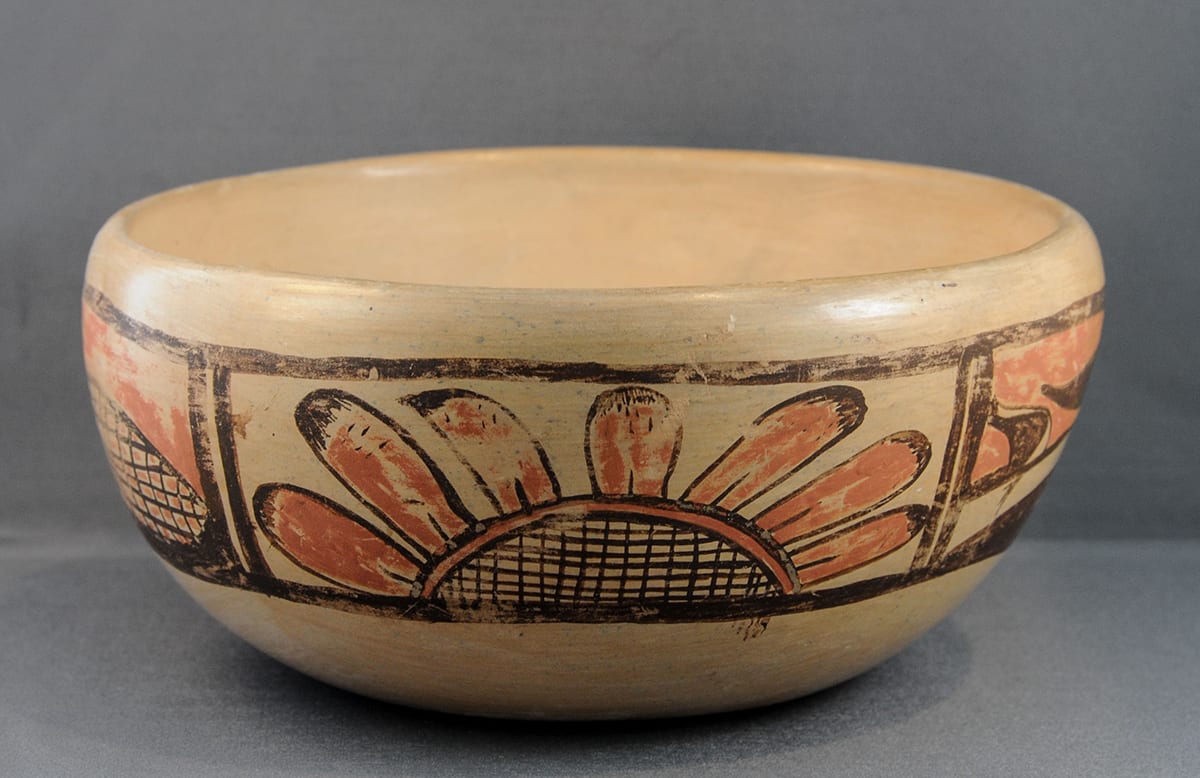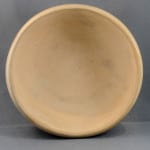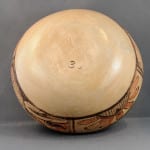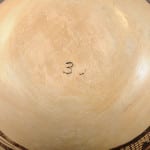The form of this pot is ordinary. The walls are thick for its size and the bowl lacks the blushing from firing that can add great visual appeal to a Hopi pot.
It’s the painting that is extraordinary.
The design is somewhat worn, with the red paint more fugitive than the black.
Unlike most Hopi or Hopi-Tewa pottery design, the images on this bowl are realistic, not abstract. Two images of an ear of corn are interspersed with half images of a flower—perhaps a sunflower. The design is framed on the top and bottom with single black lines with each panel separated from its neighbor by double black lines. The leaves of the corn are folded back and black is used to give the leaves the illusion of shadows and depth, the only example of this technique I know of on a Hopi pot. While similar, each image on the pot varies from its partner.
Both flowers have seven petals and the centers of both are filled with cross-hatching, but the cross-hatching on one flower is finer than the other. The flower with the larger cross-hatching also has a black triangular element drawn in the 12-noon position, an element that is missing from the second flower. Both ears of corn have 11 latitudinal rows of corn, but one ear is more carefully drawn and has five longitudinal rows while the second ear in more casually drawn and has seven longitudinal rows of corn.
As much as any pot in this collection, bowl 2012-07 directly expresses core Hopi values of a good life and a world in balance.
“Throughout the Southwest and Mesoamerica, songs describe a colorful, glittering, flowery paradise evoked through singing….A complex of imagery including flowers, butterflies, colorful birds and rainbows is sung into life by speakers of Uto-Aztecan languages, including the Hopi…Hopi songs describe siitalpuva, ‘along (or throughout) the flowery land,’ ‘along the fields in bloom,’ ‘the land brightened with flowers’….This flowery world is not a separate place like Christian heaven, but a reality that can be brought forth in this world through human prayers, songs, and actions…Hopi people associate flowers with moisture because moisture and warmth make flowers grow and bloom….(and the flowers also) attract moisture to benefit crops and humans” (Hayes-Gilpin and Sekaquaptewa, 2006:14).
Corn, of course, is a central concern of Hopi life:
“One of the most important metaphors likens Hopi life to corn. Corn is the foundation of Hopi life; it was so chosen at Emergence and it continues to shape and guide Hopi lives today. Corn not only provides the Hopi with sustenance but also gives them a conceptual framework that maps out their path through life. The stages of human life…are metaphorically linked to stages in the growth of corn plants…. [A] life of fulfillment comes by growing corn by hand” (Sekaquaptewa and Washburn 2006:28).
Almost all of the above understanding is taken from an extraordinary issue of Plateau Magazine published by the Museum of Northern Arizona (Vol. 3, #1, Fall 2006). For anybody interested in the Hopi worldview, this is a “must read” source.
Butterfly pots by Grace Chapella, her descendants, and others use a different iconography but express a message similar to bowl 2012. (See 2010-22 and 2011-19; also “Folk Art Butterfly Design” in the Index of Categories.) Somewhat differently, the enigmatic germination pot in this collection (2001-04) seems to express the hope for a flowery, fecund world.






